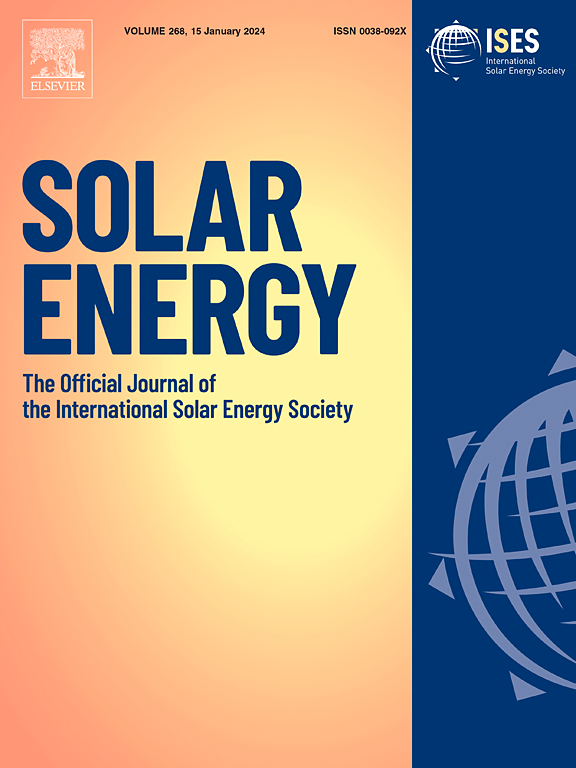Enhancing efficiency: A study on all-inorganic CsSnBr3 metal halide perovskites with micro-band offset using DFT and SCAPS-1D modeling
IF 6
2区 工程技术
Q2 ENERGY & FUELS
引用次数: 0
Abstract
In this study, we simulated a non-toxic, all-inorganic CsSnBr3 perovskite solar cell (PSC). Using first-principles PBE functional analysis, we evaluated the optoelectronic characteristics of the CsSnBr3 and performed numerical simulations and optimizations with SCAPS-1D. Our findings indicate that CsSnBr3, possessing a direct band gap of 1.78 eV, represents an optimal inorganic perovskite material for PSCs. The micro-band offset (MBO) energy structure of ZnOS/CsSnBr3/CuI, characterized by a small energy band offset, generates an intrinsic electric field (Ebi) that greatly improves carrier transport and facilitates the separation of photogenerated electron-hole pairs, resulting in a peak power conversion efficiency (PCE) of 18.89 %. Optimization of this structure involved adjusting the doping concentrations in the electron transport layer (ETL) and hole transport layer (HTL) to 1017 cm−3 for the ETL and 1019 cm−3, respectively. Increasing the absorber layer thickness improved photovoltaic characteristics, although high defect densities negatively impacted carrier diffusion length and PSC performance. Additionally, we examined the effect of varying metal back electrode (BME) and the thermal stability analysis on the PV performance of the device The micro-band offset (MBO) energy structure, as revealed by our analysis of the carrier transport pathway, enhances energy level transitions and facilitates more efficient carrier transport. Under optimal conditions, the PSCs with the MBO-energy structure demonstrated exceptional performance, with PCE = 23.98 %, Voc = 1.40 V, Jsc = 19.68 mA/cm2, and FF = 86.74 %. These results highlight the significant potential of the MBO-energy structure for Sn-based PSCs. They offer valuable insights for developing stable, highly efficient, cost-effective, and environmentally friendly CsSnBr3-based PSCs.
提高效率:利用 DFT 和 SCAPS-1D 建模研究具有微带偏移的无机 CsSnBr3 金属卤化物包光体
在这项研究中,我们模拟了一种无毒、全无机的 CsSnBr3 包晶石太阳能电池(PSC)。通过第一原理 PBE 函数分析,我们评估了 CsSnBr3 的光电特性,并利用 SCAPS-1D 进行了数值模拟和优化。我们的研究结果表明,CsSnBr3 具有 1.78 eV 的直接带隙,是 PSC 的最佳无机包晶材料。ZnOS/CsSnBr3/CuI 的微带偏移(MBO)能量结构具有能带偏移小的特点,它产生的本征电场(Ebi)大大改善了载流子传输,促进了光生电子-空穴对的分离,从而使峰值功率转换效率(PCE)达到 18.89%。该结构的优化包括将电子传输层(ETL)和空穴传输层(HTL)的掺杂浓度分别调整到 1017 cm-3 和 1019 cm-3。尽管高缺陷密度对载流子扩散长度和 PSC 性能产生了负面影响,但增加吸收层厚度还是改善了光伏特性。此外,我们还研究了不同金属背电极(BME)和热稳定性分析对器件光伏性能的影响。 我们对载流子传输路径的分析表明,微带偏移(MBO)能量结构增强了能级转换,有利于提高载流子传输效率。在最佳条件下,具有 MBO 能量结构的 PSC 表现出卓越的性能,PCE = 23.98 %,Voc = 1.40 V,Jsc = 19.68 mA/cm2,FF = 86.74 %。这些结果凸显了 MBO 能量结构在锡基 PSC 中的巨大潜力。它们为开发稳定、高效、经济和环保的 CsSnBr3 基 PSCs 提供了宝贵的启示。
本文章由计算机程序翻译,如有差异,请以英文原文为准。
求助全文
约1分钟内获得全文
求助全文
来源期刊

Solar Energy
工程技术-能源与燃料
CiteScore
13.90
自引率
9.00%
发文量
0
审稿时长
47 days
期刊介绍:
Solar Energy welcomes manuscripts presenting information not previously published in journals on any aspect of solar energy research, development, application, measurement or policy. The term "solar energy" in this context includes the indirect uses such as wind energy and biomass
 求助内容:
求助内容: 应助结果提醒方式:
应助结果提醒方式:


